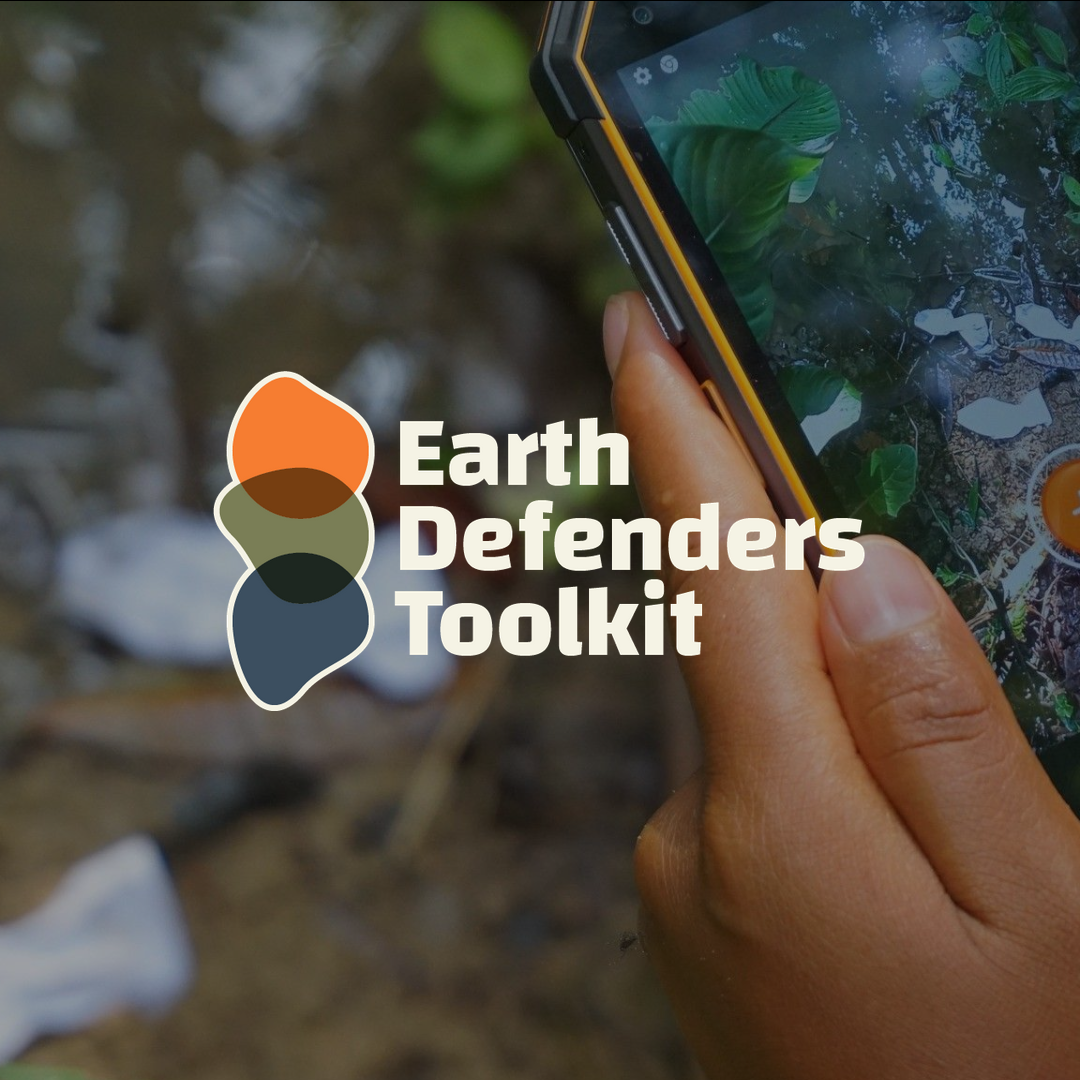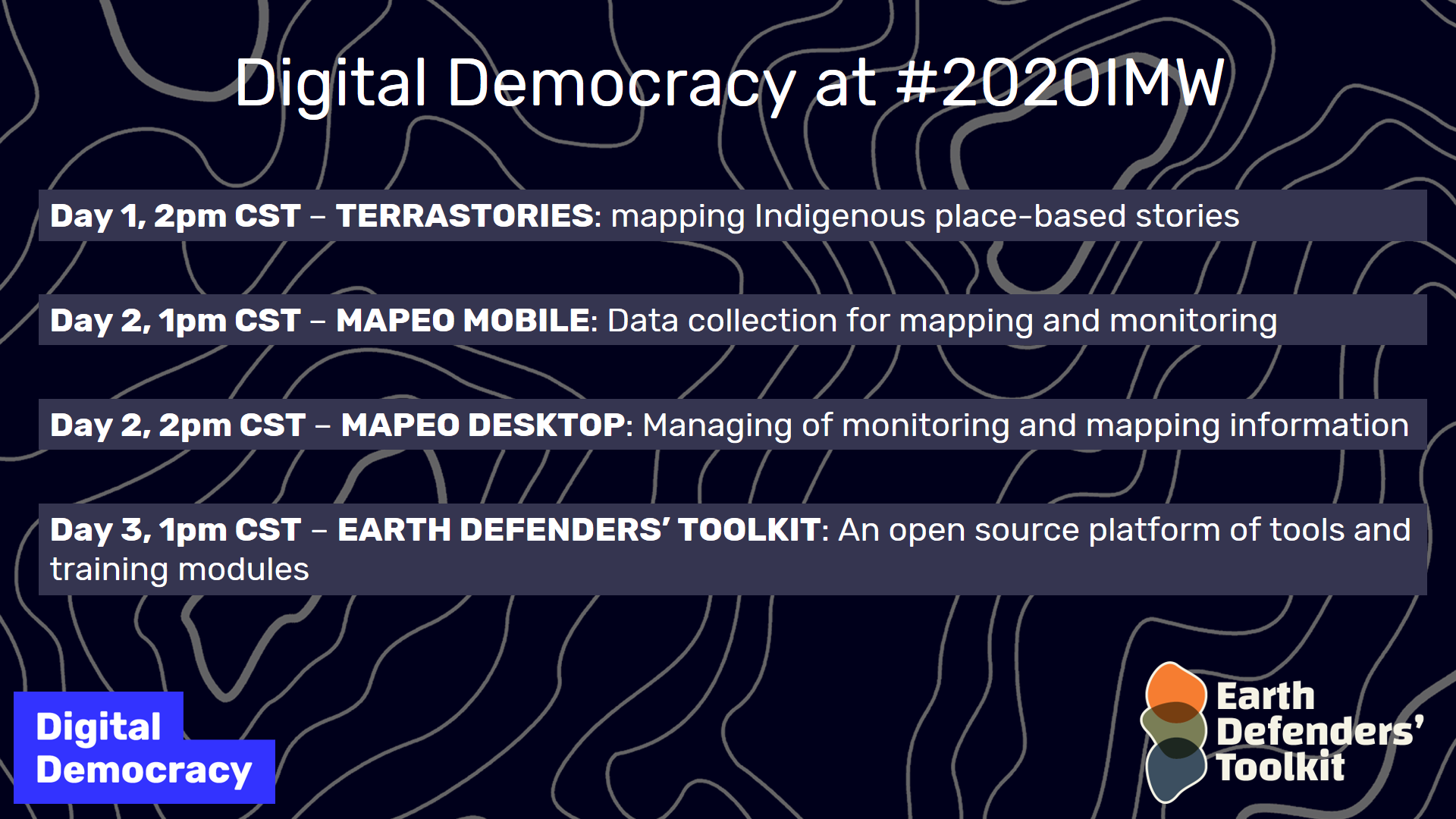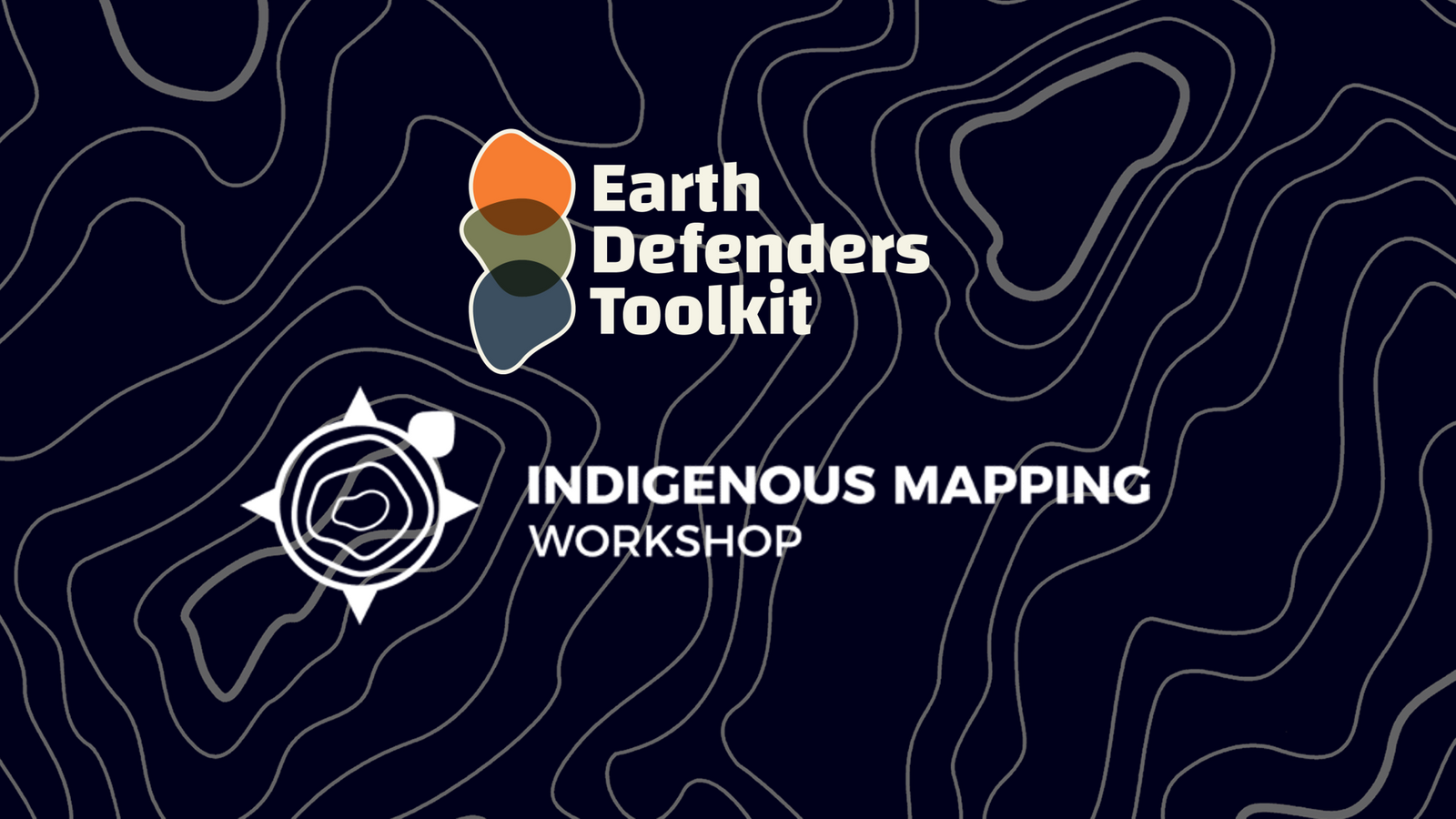Last month, Digital Democracy and our allies announced the launch of the Earth Defenders Toolkit, a new collection of open-source tools and training materials for communities on the frontlines of the struggle to defend critical ecosystems around the world.
In preparation for the public launch of the Earth Defenders Toolkit to the public, we convened a special focus group session about the Toolkit at the 2020 Virtual Indigenous Mapping Workshop, and I’m delighted to share with you some of what we learned.
But first, let me explain what exactly the Earth Defenders Toolkit is.
Earth Defenders Toolkit: A quick primer ?

The Earth Defenders Toolkit will be composed of mapping, monitoring and digital-storytelling tools, and accompanying training materials that leverage technology to support local autonomy and ownership over data. We will also be creating a collaborative platform for local community organizations and their allies and partners to co-create the toolkit and share digital knowledge. Learn more about the Earth Defenders Toolkit »
Although Digital Democracy and others have long been building tools for communities guided by principles of solidarity technology, we were inspired to steward the creation of the Earth Defenders Toolkit because we want to do better at ensuring that frontline communities can use these tools directly without creating dependency on outside support.
The Indigenous Mapping Workshop community
We are looking to engage with more communities of knowledge and practice that are already leveraging technologies to defend lands and ecosystems to help us achieve this goal of increasing community self-sufficiency and autonomy in using the Earth Defenders Toolkit. We could think of no better community to help us with insight and ideas than the Indigenous Mapping Collective, a global network of Indigenous mappers and allies that has coalesced around the ever-growing Indigenous Mapping Workshop (IMW), spearheaded by our friends at the Firelight Group.


We were honored to contribute no less than four technical sessions at this year’s at #2020IMW virtual. These included technical trainings for Mapeo Desktop, Mapeo Mobile, and Terrastories, and one special interactive session on Earth Defenders Toolkit — the project’s very first unveiling! ?
My colleague Jen Castro and I had the privilege of hosting the 45 minute session on Earth Defenders Toolkit. We decided to organize the session around Indigenous ally protocols of being clear on what we are offering, and open to receiving. We also wanted to make our session be as helpful as possible for the community by creating the space for people to stay in touch with each other and sharing their needs and abundances, and structured the session to be the start of a broader conversation and the emergence of a community around earth defender tools for Indigenous peoples worldwide.
With permission of participants, we are sharing our virtual welcome circle and a few key insights that we will carry forward in the design of the Earth Defenders Toolkit.
Earth Defenders Toolkit: Insights from the Indigenous Mapping Community

1. What does “earth defender” mean to you? ?
“Aj Kanan / Ix Kanan: the one who cares for the land, the forest, the cenotes.”
We opened the session by asking participants to share a place that is meaningful to them, followed by this important question: what does “earth defender” mean to you? It’s difficult to neatly summarize all of the general and meaningful contributions, but we identified several cross-cutting themes that enrich our reference points as we develop the Earth Defenders Toolkit:
- All my relations; being a good relative (to more than just the human)
- Taking care of the land; a voice for the land
- Reciprocity and interconnectedness with all spirits and life
- Protecting, defending, and caring for the land in the way our ancestors have for generations
- A strong sense of place; place-based knowledge
- A community of people who care, honor the gift of life, and are thinking of the future
2. Who is doing mapping/monitoring in your community, and who should be more involved? ✋
“It should be open and accessible to all Nation members — making sure no one gets left behind.”
Our next exploration asked participants to consider the people we need to think about when making choices on what to share, and how to do that. What was shared:
- Who is currently involved: state government staff (i.e. lands, environmental stewardship department), Indigenous monitors and rangers, tribal government, non-Indigenous NGOs and consultants, private archeology firms, land users.
- Who should be more involved: Indigenous youth. Also, rural people with little or no access to the internet or computers, and in general, all community members.
Lesson(s) learned for the Earth Defenders Toolkit: One of the takeaways here is the emphasis on Indigenous youth — a good number of people expressed that young people should be more involved in the future.
3. The tool shed ?
“Tea and bannock (fry-bread)”
What are people using to do earth defense work? These could be specific use, easy to use, multifunctional, or complex tools. While some folks named specific mapping and monitoring technologies (such as OpenStreetMap, Mapbox, ODK Collect), what stands out here is the range and diversity of responses that really challenge our conception and imagination of what “tools” can be. Some of the responses included:
- Rubber boots!
- Journal and pencil
- Walking and talking; active listening
- Workshops and community gatherings; shared meals
- Cell phones and tablets; voice recorders and video cameras
- Social media; Facebook and YouTube
- Storytelling and knowledge exchange; place names; sharing Mo’olelo
- A good sense of humor
Lesson(s) learned for the Earth Defenders Toolkit: We can’t put all tools in the box. That is because humans are incredibly creative and innovative and can make almost anything a tool to help us face a challenge. Even some of our most primordially human skills — cooking good food, and having a good sense of humor — can help bring people together, and build community power. We need to avoid being rigid in defining “tools” or “technologies” as digital hardware and software, and think about how to make room for also leveraging non-digital and Indigenous/ancestral technologies.
4. What are some learning frameworks that have worked for you (or not)? ?
“Tik Tok language and beading tutorials”
One of the considerations we have in building the Earth DefendersToolkit is that toolmakers too often work on manuals or guides that end up compiled as an ugly PDF document that few want to read or use.. We want for our learning frameworks to be helpful and appropriate for our users, so we asked how folks prefer to learn. This is a selection of what we heard:
- Social media: participants highlighted popular social media channels like Instagram, TikTok, YouTube, and Facebook as environments where they are currently learning and also connecting with other land defenders. Also, a few participants mentioned memes.
- Frameworks based on traditional knowledge: intersecting with traditional knowledge, or, with relevant examples that can be translated to my situation.
Lesson(s) learned for the Earth Defenders Toolkit: consider sharing materials on channels and environments where people are already communicating and networking such as social media, and create materials that directly apply to people’s worldview and lived experiences.
5. What do you hope to gain from a community around Earth Defenders Toolkit? ?
“To give back”
Our final prompt generated many amazing responses, but this selection is particularly relevant for the Earth Defenders Toolkit:
- Connecting on social media; social distance powwow; I wonder what it would be like to have an Indigenous made social app so that we may have self determination of our own media channels
- Networks ‘survive’ digitally — they THRIVE in person.
- Transfer of knowledge around success stories — what works and can be replicated elsewhere; how other Indigenous cultures have successfully gained some type of sovereignty
- Respectful, safe spaces to bounce ideas off of; people to ask questions to
- Creating secure, lasting places for First Nations knowledge in the modern world
- Solidarity; to give back
In closing: gratitude

On behalf of Digital Democracy, Jen and I are incredibly grateful to our friends at the Indigenous Mapping Workshop for giving us the space and opportunity to share what we’re building, and to learn from and engage with the community. We also would like to thank everyone that participated in our Earth Defenders Toolkit session, and hope to keep learning from you as we co-create the Toolkit and release more content in the near future.
To stay in touch with us, please subscribe to our mailing list at https://earthdefenderstoolkit.com/ and stay tuned as we will be creating spaces for communities to stay informed, engage and grow in 2021.

